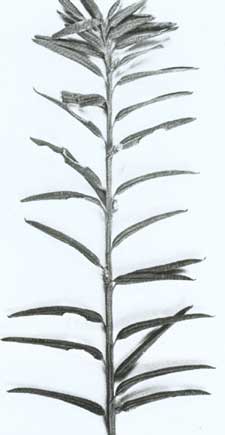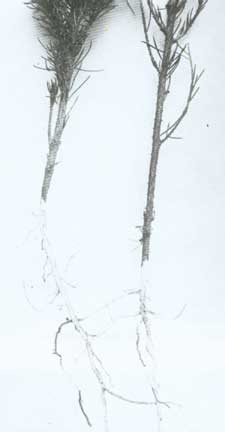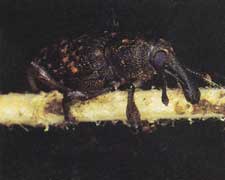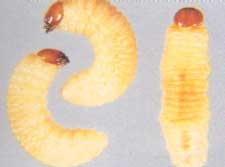WeevilsWilliam H. Hoffard - Entomologist, Region 8, USDA Forest Service, Asheville, NC. Cordell C.E., Anderson R.L., Hoffard W.H., Landis T.D., Smith R.S. Jr., Toko H.V., 1989. Forest Nursery Pests. USDA Forest Service, Agriculture Handbook No. 680, 184 pp. Hosts Weevils (family Curculionidae) feed on a wide variety of plants. In forest nurseries, seedlings of many species, especially hemlock, spruce, and Douglas-fir, may be severely attacked. The most destructive weevils in nurseries are members of the genus Otiorhynchus (Brachyrhinus). These weevils, collectively referred to as root weevils, include the strawberry root weevil, 0. ovatus ; the black vine weevil, 0. sulcatus; and the rough strawberry weevil, 0. rugusostriatus. Other weevil species that can cause problems in nurseries are the pales weevil, Hylobius pales; the pitch-eating weevil, Pachylobius picivorus; the Japanese weevil, Pseudocneorrhinus bifasciatus; and the yellow-poplar weevil, Odontopus calceatus. Distribution The most severe losses due to weevils have been observed in the West, but damage can occur almost anywhere. Damage Weevils sometimes cause serious damage to various species of conifer seedlings, especially in the West, where they are among the most serious insect nursery pests. Outright mortality may be widespread. Heavy culling is sometimes necessary due to severe damage. Diagnosis On aboveground plant parts, look for needles with notches or holes (fig. 52-1) or stems with small sections of bark removed. Infested roots may be entirely stripped of their bark for several centimeters (fig. 52-2) or debarked on only one side. Root-damaged trees may show symptoms reminiscent of damage due to root pathogens. Adult weevils have well-developed snouts with clubbed, elbowed antennae (fig. 52-3). Adults can be found in the soil litter layer during the day and on foliage at night. (Some species estivate in the soil during hot summer months and become active in the fall.) Larvae are legless and C-shaped, with shiny, smooth heads and pale, cylindrical bodies (fig. 52-4). Biology The life histories of weevils vary according to species and geographic influences. A generalized life history of the root weevils mentioned earlier will serve as an example. Weevils overwinter as larvae or sometimes as pupae and adults at soil depths of 6 to 8 in. They emerge as adults from early May to late July. These adults are present throughout the remainder of the growing season. Sometimes there are two weevil generations per year, but one is more common. The weevils are night feeders, preferring to hide beneath leaves, stubs, stones, and other debris during the day. At night, they become active, climbing seedling stems and eating notches in needles and stems. Egg-laying begins about 2 weeks after adults appear and continues until September. In about 20 days, the eggs hatch, and the tiny larvae move deeper into the soil, where they feed first on fine roots and later on larger roots. Pupation occurs in cells just beneath the soil surface. Control Cultural - Practicing clean cultivation, rotating transplant beds, and allowing infested areas to lie fallow and be thoroughly cultivated in alternate years are effective methods of reducing weevil populations. Chemical - Fumigate seedbeds with a methyl bromidechloropicrin formulation before seeds are sown. Fumigation is very effective in controlling soil-inhabiting insects like weevils. Selected References Furniss, H. L. Carolin, V.M. 1977. Western forest insects. Misc. PubI. 1339. Washington, DC: U.S. Department of Agriculture 328- 330. Smith. F.F. 1932. Biology and control of the black vine weevil. Tech. Bull. 325. Washington. DC: U.S. Department of Agriculture. 45 p. U.S. Department of Agriculture, Forest Service. 1985. Insects of eastern forests. Misc. PubI. No. 1426. Washington, DC: U.S. Department of Agriculture: 318-334. |
Forest Pests: Insects, Diseases & Other Damage Agents |

|
|





